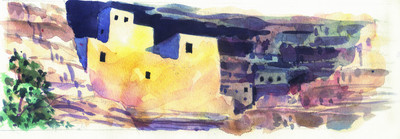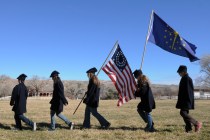Autumn perfect season to check out Montezuma Castle
Abandoned at least a century before Spanish explorers began to probe the American Southwest, prehistoric cliff dwellings in Central Arizona continue to fascinate and puzzle visitors. Montezuma Castle National Monument preserves a multistoried cliff dwelling built by the Sinagua people into a natural overhang of rock as well as related ruins at a water-filled sinkhole called Montezuma Well a few miles away.
Autumn brings balmy temperatures and seasonal color to the canyons that once nurtured people of prehistory who farmed, hunted and gathered natural foods. The ruins lie about 50 miles south of Flagstaff off Interstate 17 along Beaver Creek, a tributary of the Verde River. Southern Nevadans exploring the area find many points of interest in the beautiful Verde Valley within a six-hour drive of Las Vegas. A network of scenic secondary roads near Sedona and Prescott provides access.
To reach Montezuma Castle, watch for exit 289 toward Camp Verde. Turn off, then turn left to parallel the freeway. Follow the signs a couple of miles to the small monument set amid stands of trees along the creek. Begin your experience at the visitor center with its explanatory exhibits, displays of cultural artifacts, and well-stocked book and gift shop. Then walk to view the ruins on a loop trail.
Expect to pay a $5 entrance fee, also good for your visit to neighboring Montezuma Well if you save the receipt. Holders of national park passes pay no fee or reduced fees. Open year-round for day-use only, the park contains picnic areas but no campgrounds.
The ancient people used whatever their location offered. The canyon provided access to water, flat areas for crops, stands of sycamore, ash and cottonwood for shade and building materials, and rich variety in plants and animals. The cliffs offered a soft limestone for walls and a good base for a 45-room, six-story complex, now greatly deteriorated. The industrious Sinagua made good use of the nearby overhang where they constructed a five-story, 20-room pueblo 100 feet above the cliff base. More than 600 years old, Montezuma Castle remains one of the most striking and best preserved of the ruins in the Southwest.
For lack of their real name, lost in history, archaeologists tagged them with a modern name taken from Spanish for "without water," because of their desert environment. The Sinagua perfected irrigation systems to channel water toward their plots of corn, squash, beans and cotton. They used cotton and other fibers to make textiles and twine. They created stone implements, baskets for many uses and fine pottery, highly polished, but unadorned. They mined salt for trade with other groups in a trading network that spanned hundreds of miles.
The Sinagua lived well in many locations in the area for several hundred years. For reasons not understood, they abandoned their comfortable lifestyle in the 1300s and disappeared. Other ancient cultural groups moved on and dispersed about the same time. Experts still puzzle over why they left.
Montezuma Well lies 11 miles from the main part of the national monument. To reach it, return to I-17 and turn north. Use the McGuireville-Lake Montezuma exit and follow the signs several miles from the freeway to the water-filled limestone sinkhole.
At Montezuma Well, a small lake fed by three warm springs, the Sinagua built stone walls for connected rooms under the lip of the protecting rim above the water.
They also constructed early pit houses and above-ground pueblos, now in ruins. Remains of an extensive irrigation system indicate where they farmed. Pioneer settlers made use of the channels to water their own fields hundreds of years after the Sinagua left.
Army doctors stationed at nearby Fort Verde were among the first whites in the region to explore the ancient ruins. More scientists than surgeons, their early sketches, photographs and collections of artifacts documented the sites before less benevolent looters got to them. Eventually, interest in these ancient sites dictated they be protected with park status and interpreted for legitimate visitors.
Margo Bartlett Pesek's column appears on Sundays.
MARGO BARTLETT PESEKMORE COLUMNS






















